The Angel and the Head-huntress
A Reading of Plate 47 of the Mnemosyne Atlas
edited by Seminario Mnemosyne, coordinated by Maria Bergamo, Giulia Bordignon, Monica Centanni with Silvia De Laude, Enkelejd Doja, Bianca Maria Fasiolo, Anna Fressola, Alberto Giacomin
English version by Elizabeth Thomson
Versione italiana
The reading of the pPanel 47 of the Mnemosyne Atlas proposed here is illustrated via thematic and plastic routes. A first analysis cuts the Panel into two vertical sections, thematically divided into similar subgroups: on the left side are grouped figures from the New and Old Testament who perform episodes of protection (The young Jesus returning from the Temple, Tobias accompanied by the angel); on the right side are grouped figures from the Bible, protagonists of violent acts of aggression (Judith, Salome, Sampson). A second analysis identifies plastically defined formulas of pathos that cross the previous thematic paths: the gesture of protection and care indicated by leading by the hand (angel and Mary); the gesture of the guide indicating the way (the angel); the act of aggression (Judith, Sampson); the graceful gait of the ancient nymph emerges in the elegant movements of the angel, and the seductive footstep of the head-huntress (Judith and Salome).
Thematic paths
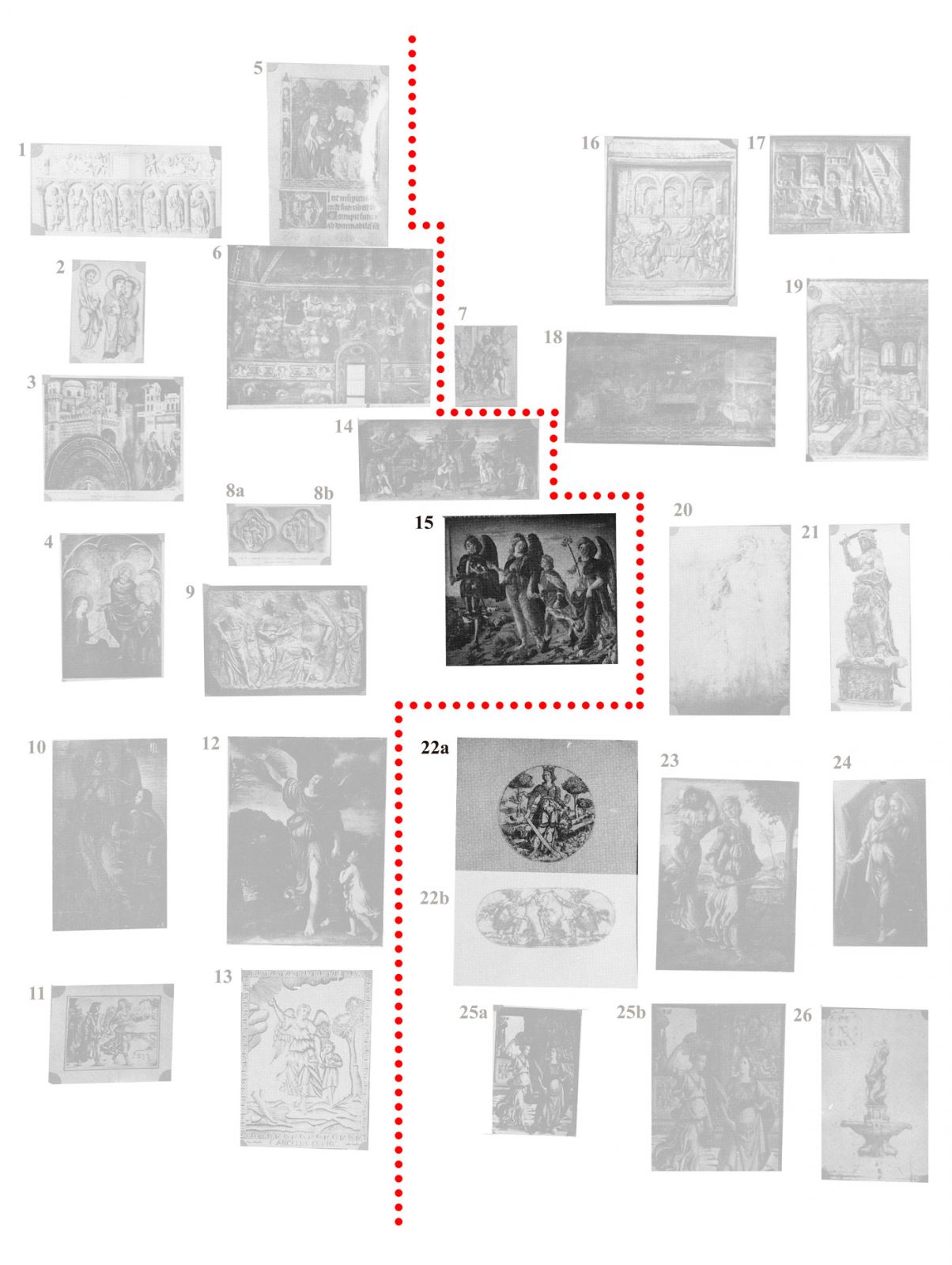
The thematic focus of the plate is the two works at the centre: Tobias and the Three Archangels by Francesco Botticini [47.15] and the engraving on copper representing Judith with the Head of Holofernes [47.22a]. These two images and their placement at the centre of the plate create a sort of hinge which splits the montage in two sections.
The characters from the Old and New Testament that appear in the plate are the protagonists of different forms of enterprise, in a montage where themes of initiation into adulthood, protection, justice, heroic and bloody action touch and overlap each other, in meta-thematic, iconographic and gestural pathways.

Mnemosyne Atlas, Panel 47 (details from Mnemosyne 1929, by Warburg and coll.): figg. 47.15, 47.22a.
47.15 Francesco Botticini, The Three Archangels and Tobias, tempera on wood panel, 1467, Florence, Uffizi Gallery; 47.22a Judith Holding the Head of Holophernes, etching from Florence, c.1465, London, The British Museum.
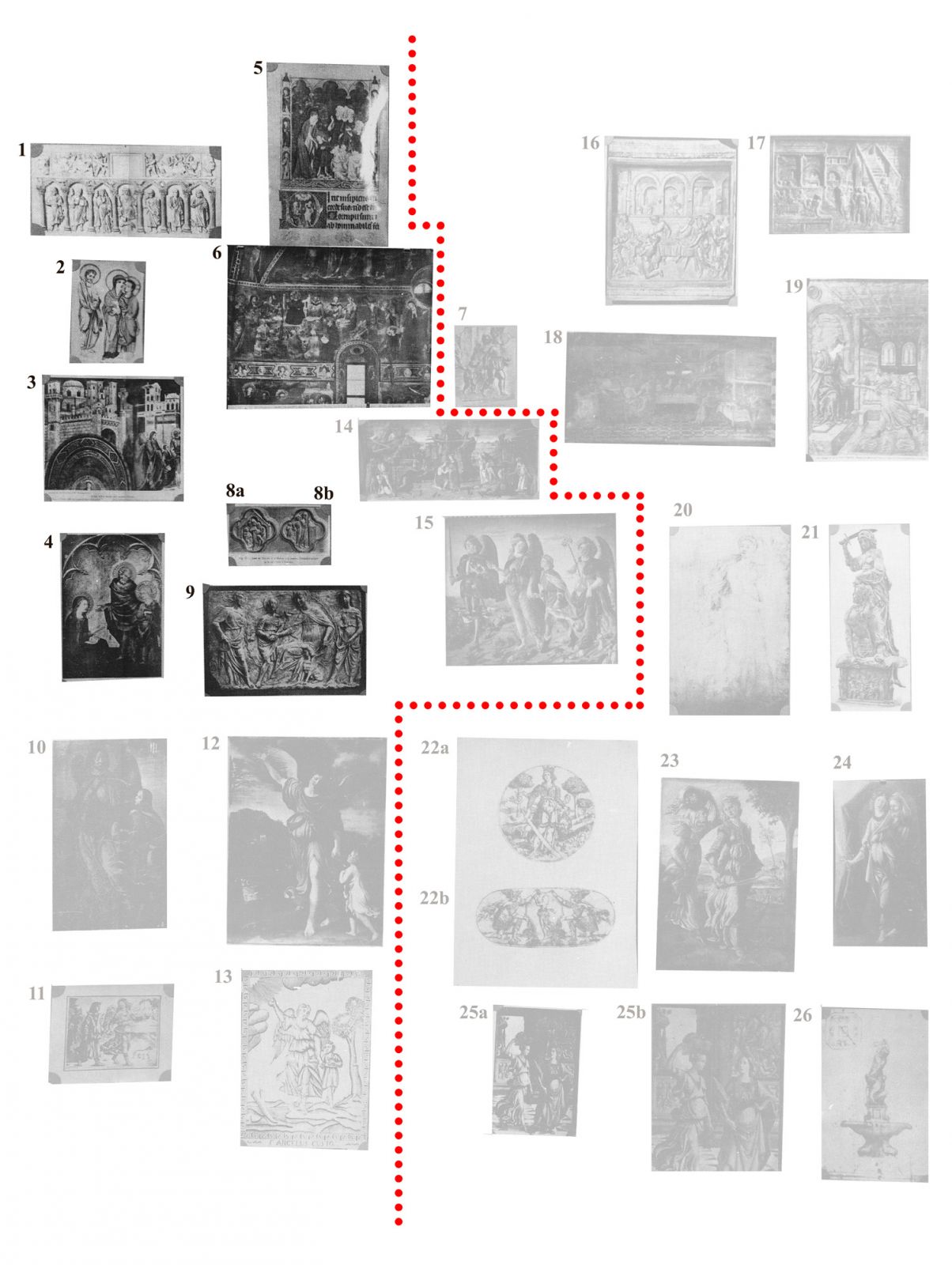
In the left section, a first group includes images related to the Dispute of Christ among the Doctors, and in particular the theme of the finding of Jesus in the Temple by Mary and Joseph, an episode – present only in the Gospel of St. Luke – which has the function of emphasising Child Jesus’ awareness of his mission. Joseph and Mary with Jesus age twelve (age of initiation in the Jewish tradition and others) had gone to Jerusalem as was the custom for the feast of the Passover:
Every year Jesus’ parents went to Jerusalem for the Festival of the Passover. When he was twelve years old, they went up to the festival, according to the custom. After the festival was over, while his parents were returning home, the boy Jesus stayed behind in Jerusalem, but they were unaware of it. Thinking he was in their company, they travelled on for a day. Then they began looking for him among their relatives and friends. When they did not find him, they went back to Jerusalem to look for him. After three days they found him in the temple courts, sitting among the teachers, listening to them and asking them questions. Everyone who heard him was amazed at his understanding and his answers. When his parents saw him, they were astonished. His mother said to him, “Son, why have you treated us like this? Your father and I have been anxiously searching for you.” “Why were you searching for me?” he asked. “Didn’t you know I had to be in my Father’s house?”[f] But they did not understand what he was saying to them. Then he went down to Nazareth with them and was obedient to them. But his mother treasured all these things in her heart. 52 And Jesus grew in wisdom and stature, and in favor with God and man (Lc 2, 41-52).
The iconography of the Finding of Jesus in the Temple has two variants: one in which Joseph searches for the child and returns him to his mother who, sitting, receives him with a gesture of apprehension and reproach combined [47.4]; in the other variant, both parents find Jesus and take him home holding him by the hand [47.6, 47.8b]. The episode has an extensive iconographic fortune from the end of the fifteenth century: in images, the theme focusses mainly on the apprehension of Mary and Joseph for their son lost in Jerusalem. The pathetic element humanises the image of Mary as a mother, but also of Jesus as a child who like all children needs care and protection [47.2, 47.5, 47.9].
The first image top left – taken from a fourth-century sarcophagus reused as the tomb of Saint Giles in the Church of San Bernardino in Perugia – is generally read as Christ Enthroned with the Personifications of Ecclesia and the Apostles [47.1]. The image is included in the montage probably for thematic affinities: the young Christ, seated in the act of teaching the apostles and elders with a female figure is comparable with the conventional iconography of Jesus among the Doctors, and the female figure (Ecclesia) can be interpreted as Mary at the Temple to retrieve her child [47.5]. The image in the fresco from the Chapel of St. Nicholas of Tolentino [47.6] is a fusion of the two episodes.

Mnemosyne Atlas, Panel 47 (details from Mnemosyne 1929, by Warburg and coll.): figg. 47.1, 47.5, 47.6.
47.1 Christ, Ecclesia and Apostles, drawing from a sarcophagus bas-relief, sec. IV, reused for the tomb of Saint Giles, in the Church of San Bernadino Perugia; 47.5 Christ among the doctors, miniature from "Queen Mary's Psalter", 1310-1330, Royal Ms. B VII, fol. 150v, The British Library; 47.6. Maestro di Tolentino or Maestro della Cappella di San Nicola, Christ among the Doctors, Mary and Joseph leave the temple, fresco, 1340-1348, Tolentino, Church of San Nicola.
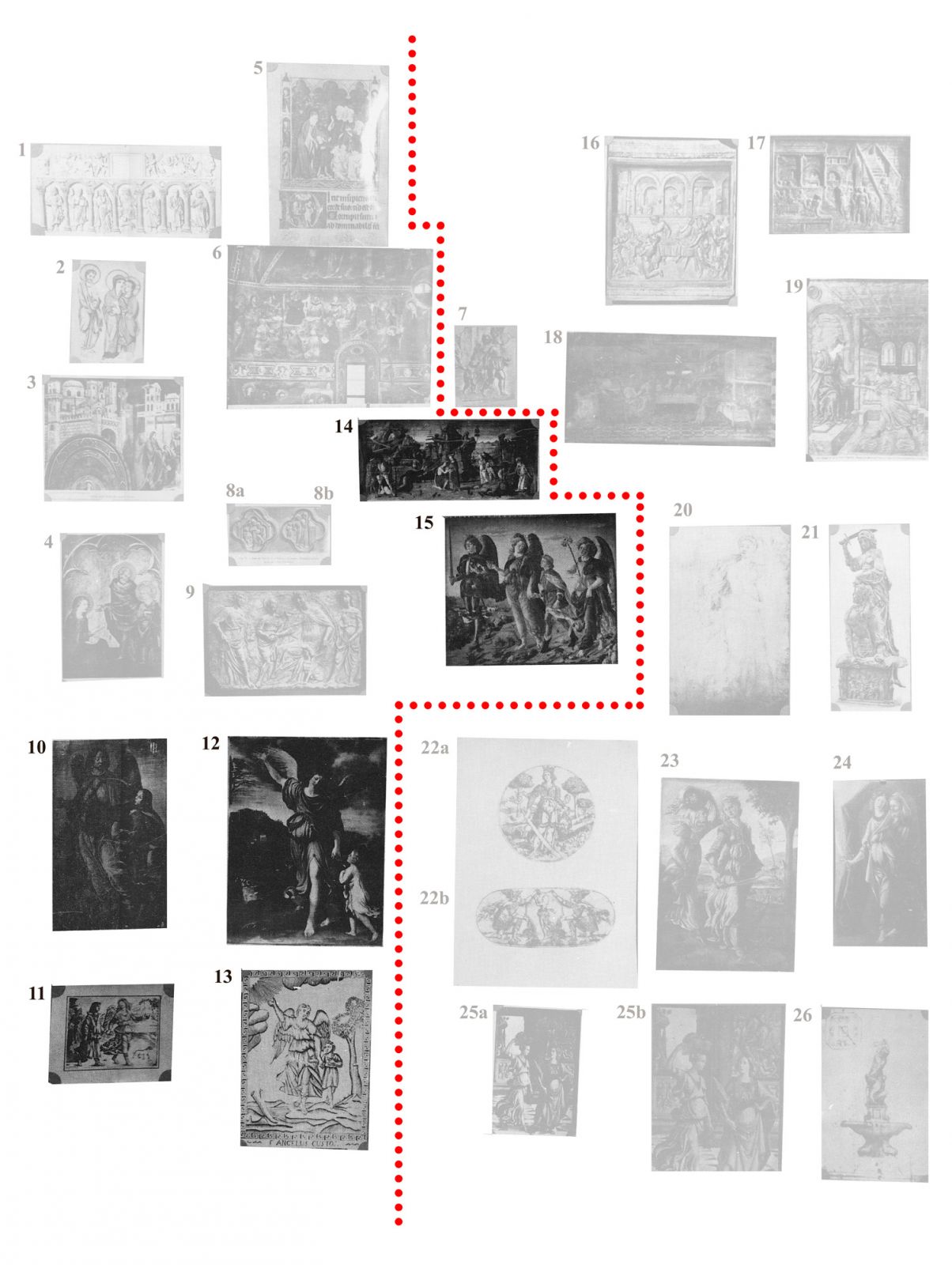
A second group in the left section includes images related to the biblical episode of Tobias accompanied by the Archangel Raphael, the subject of a book in the Old Testament accepted by the Roman Church only with the Council of Trent, but not included in the biblical canon by Protestants or by the Jews. The young Tobias leaves his paternal home to seek his fortune and find a wife (Sarah). In the story, Archangel Raphael appears in the guise of a trusted companion, and not as an angel:
Then his father answered him, and said: I have a note of his hand with me, which when thou shalt shew him, he will presently pay it. But go now, and seek thee out some faithful man, to go with thee for his hire: that thou mayst receive it, while I yet live. Then Tobias going forth, found a beautiful young man, standing girded, and as it were ready to walk. And not knowing that he was an angel of God, he saluted him, and said: From whence art thou, good young man? But he answered: Of the children of Israel. And Tobias said to him: Knowest thou the way that leadeth to the country of the Medes? And he answered: I know it: and I have often walked through all the ways thereof (Tobias 5, 3-8).
This is the description of the son’s farewell to his father:
Then all things being ready, that were to be carried in their journey, Tobias bade his father and his mother farewell, and they set out both together. Anna, young Tobias’ mother, mourns his departure. And when they were departed, his mother began to weep, and to say: Thou hast taken the staff of our old age, and sent him away from us. I wish the money for which thou hast sent him, had never been. For poverty was sufficient for us, that we might account it as riches, that we saw our son. 26 And Tobias said to her: Weep not, our son will arrive thither safe, and will return safe to us, and thy eyes shall see him. 27 For I believe that the good angel of God doth accompany him, and doth order all things well that are done about him, so that he shall return to us with joy (Tobias, 22-28).
The young boy’s journey has all the characteristics of an initiation: the transition to adulthood, marriage and success. In the journey, Tobias and his divine guardian catch a fish together. The fish proves to be a miraculous talisman and becomes the iconographic attribute par excellence of the Archangel Raphael, whose name in Hebrew means “medicine of God”.
In fifteenth-century Florence, this subject was successful in devotional and votive images, and expressed the complex beliefs and outlooks of the merchant class that Warburg chose as ‘exemplum’ of their conflicting tensions during the early Renaissance.
In 1455, the “Society of Archangel Raphael”, founded by the Florentine merchant class at the beginning of the fifteenth century, was given permission to gather at the Church of the Holy Spirit. An altar of the company has been in existence since 1483 (the second chapel in the right aisle), above which was placed a painting depicting the Three Archangels by Francesco Botticini [47.15]: Botticini himself was a member of the Company (as were other famous artists of the period, including Neri di Bicci and Verrocchio, who depicted the same subject) and called his own son Raphael.
In fifteenth-century Florence, Archangel Raphael was the patron of young sons of merchants sent on business ventures far from the family home. In this sense, works that had as their subject Tobias and the Angel were perfect votive offerings for successful commercial enterprises. In another painting by Botticini included in the plate [47.10], Raphael accompanies and protects Tobias who has the features of Raphael Doni, son of Attaviano di Jacopo, a member of the Confraternity, who was a wool merchant and dyer. The painting comes from the church of Badia Fiorentina where he lived. Thus, rather than their souls, the companies of the Florentine merchants entrusted the winged protector with the lives of their sons and their fortunes, constantly exposed to the winds of fate or, in other words, the divine plan. Angels who in short, in the sense of votive offerings by merchants, inherit the role of protectors of life and property from the pagan Fortuna-Tyche (it is no coincidence that the subject of the next plate, Panel 48, is Tyche-Fortuna).

Mnemosyne Atlas, Plate 47 (details from Mnemosyne 1929, by Warburg and coll.): figg. 47.10, 47.15.
47.10 Francesco Botticini, Tobias and the Angel, and the Young Donor (son of the patron, Raffaello Doni), tempera on wood panel, c. 1495, Florence, Santa Maria del Fiore, the Old Sacristy; 47.15 Francesco Botticini, The Three Archangels and Tobias, tempera on wood panel, 1467, Florence, Uffizi Gallery.
Continuing with tradition and popular devotion, Archangel Raphael accompanying Tobias on his journey undergoes another shift and becomes a guardian angel [47.11, 47.13]. Raphael, from being Tobias’ personal angel – who guards and protects the young boy and introduces him to life as an adult – gradually loses his personality, his iconographic attribute of the fish and the role given to him in the Bible, becoming a generic guardian angel. In parallel, Tobias loses his personality and youth, and regresses to being a young child.
The theme of protection underlying this figurative subject breaks through the barriers of its Biblical origins and takes root in a widespread popular cult that, starting from the sixteenth century, was officially recognised by the Church of Rome. The cult of the guardian angel was established at the beginning of the sixteenth century by the Bishop of Rodez, François d'Estaing, who celebrated the first mass in honour of the angel on 3 June 1526. The cult was subsequently promoted by the Jesuits, who made it one of the cornerstones of the education of young people and promoted the creation of brotherhoods in the angel’s name. Protestants, on the other hand, with their strict reading of biblical sources and their strategy of revising the cult of saints and all the minor subjects of devotion, prohibited reverence for the guardian angel, regarding it as superstition.

Mnemosyne Atlas, Plate 47 (details from Mnemosyne 1929, by Warburg and coll.); figg. 47.10, 47.15, 47.11, 47.14 (part.), 47.12, 47.13.
47.10 Francesco Botticini, Tobias and the Angel, and the Young Donor (son of the patron Raffaello Doni), tempera on wood panel, c. 1495, Florence, Santa Maria del Fiore, the Old Sacristy; 47.15 Francesco Botticini, The Three Archangels and Tobias, tempera on wood panel, 1467, Florence, Uffizi Gallery; 47.11 Giulio Campagnola, Tobias and the Angel Raphael, etching on copper, c.1500; 47.14 (det.) Jacopo del Sellaio, Scenes from the Lives of the Saints. Tobias and the Angel (to the right), chest, second half of 15Cth, Göttingen, Universitätsmuseum; 47.12 Guercino, Tobias and the Angel Raphael, oil on copper, 1624-1626, Rome, Galleria Colonna; 47.13 Tobias and the Angel, print by Giorgio Nicodemi, in I legni incisi dei Musei Bresciani, Brescia 1921, p. 32.
The gradual assimilation of devotion to Archangel Raphael with the later and longer lasting cult of the guardian angel is also indicated visually by the superimposition of the gesture and the attributes of the guardian angel with Archangel Raphael in the works of Botticini and Guercino. The iconography of the angel tends, over time, to generalize: from travelling companion – with all the attributes of pilgrim – walking stick, knapsack, fish and dog – and switches to a figure in fluttering robes pointing to the sky.

Mnemosyne Atlas, Plate 47 (details from Mnemosyne 1929, by Warburg and coll.): figg. 47.10. 47.11, 47.12, 47.13.
47.10 Francesco Botticini, Tobias and the Angel, and the Young Donor (son of the patron Raffaello Doni), tempera on wood panel, c. 1495, Florence, Santa Maria del Fiore, Old Sacristy; 47.15 Francesco Botticini, The Three Archangels and Tobias, tempera on wood panel, 1467, Florence, Uffizi Gallery; 47.11 Giulio Campagnola, Tobias and the Angel Raphael, etching on copper, c. 1500; 47.12. Guercino, Tobias and the Angel Raphael, oil on copper, 1624-1626, Rome, Galleria Colonna; 47.13 Tobias and the Angel, print by Giorgio Nicodemi, in I legni incisi dei Musei Bresciani, Brescia 1921, p. 32.
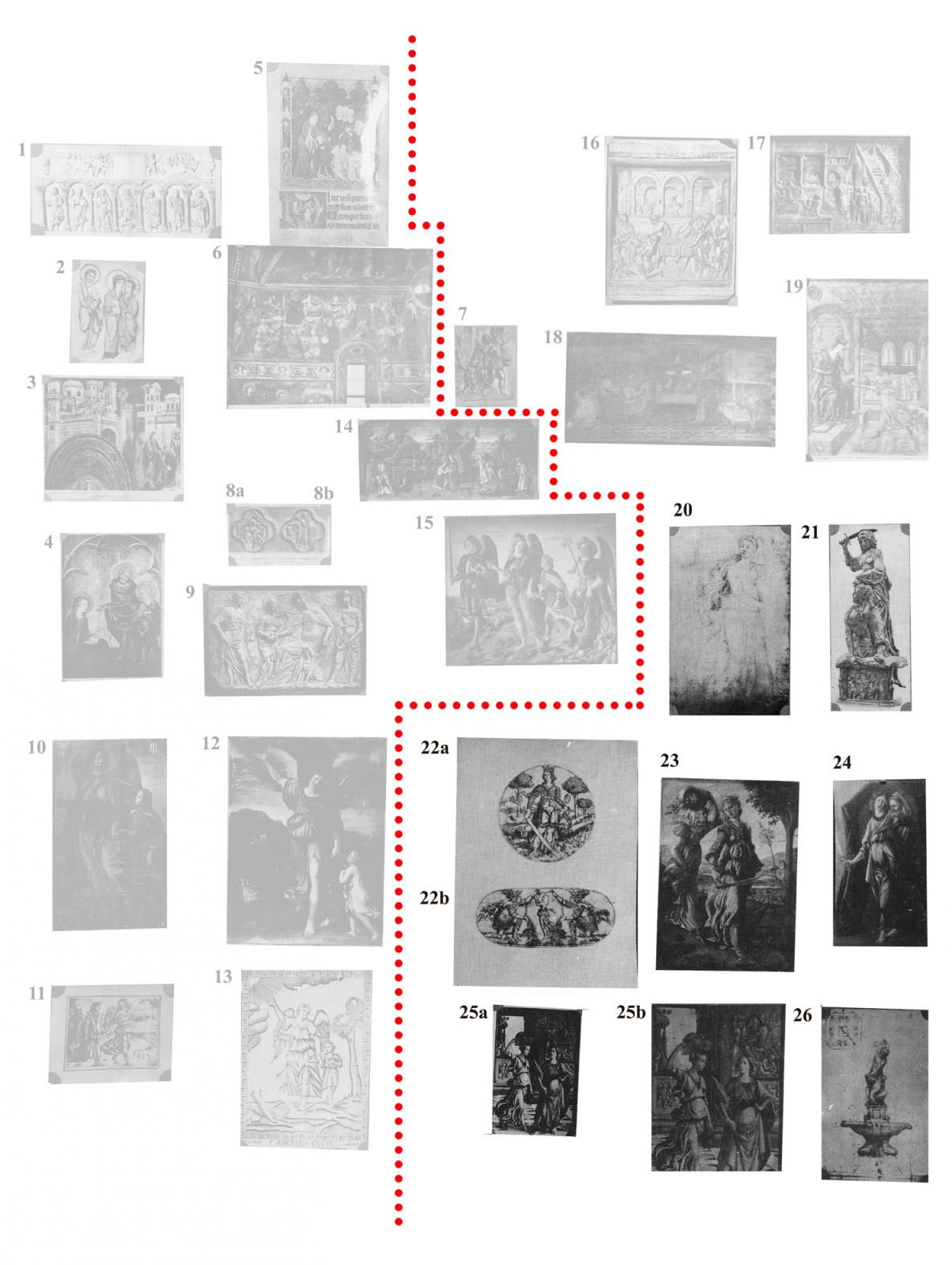
Moving on to the second section, the centre of the plate is dominated by an image of Judith, with a drawn sword and the head of Holophernes [47.22a], positioned above the personification of Hope [47.22b]: the image of the Old Testament heroine has an important role at the point where the themes intersect, and marks a significant shift between the right side and the left side of the panel. In the biblical text Judith – an entire book is dedicated to her – is the young girl who saves her people from the authority of the Assyrian troops, seducing and then decapitating their leader, Holophernes:
And Judith was alone in the chamber. But Holophernes lay on his bed, fast asleep, being exceedingly drunk. And Judith spoke to her maid to stand without before the chamber, and to watch: And Judith stood before the bed praying with tears, and the motion of her lips in silence, Saying: Strengthen me, O Lord God of Israel, and in this hour look on the works of my hands, that as thou hast promised, thou mayst raise up Jerusalem thy city: and that I may bring to pass that which I have purposed, having a belief that it might be done by thee. And when she had said this, she went to the pillar that was at his bed's head, and loosed his sword that hung tied upon it. And when she had drawn it out, she took him by the hair of his head, and said: Strengthen me, O Lord God, at this hour. And she struck twice upon his neck, and out off his head, and took off his canopy from the pillars, and rolled away his headless body. And after a while she went out, and delivered the head of Holophernes to her maid, and bade her put it into her wallet. And they two went out according to their custom, as it were to prayer, and they passed the camp, and having compassed the valley, they came to the gate of the city (Judith 13, 3-20).
Judith is the woman led by God to free Israel of its oppressor, and the people of Israel sing a blessing to her, much like another head-huntress, whose story is told in the book of Judges (4, 17-22). It is interesting that the same tones of the hymn in honour of the biblical heroines are echoed in the Magnificat, the canticle of Mary at her encounter with Elizabeth (Luke 1: 46-56; identification of Mary with Old Testament heroines, see, M. Bergamo, Maria: la donna della forza, in “La Rivista di Engramma” 6, February/March 2001).
From the fourteenth century, in both political and civic contexts, Judith becomes an allegory of victory over tyrants and symbol of the freedom of Italian comuni and signorie. In the development of this allegorical shift, the heroine also becomes the figure of Justice, an assimilation favoured by the popular etymology of Judith/Iustizia, and by the sword being both a conventional attribute of Judith and a symbol of Justice. The allegory Judith/Justitia is especially vital in the last quarter of the fifteenth century: an example is the Judith-Justice in the frescoes by Giorgione and Titian on the water frontage of the Fondaco dei Tedeschi, as a representation of the 'Justice of Venice'.
Judith therefore appears as a figure of Liberty-Justice, but also of hope for freedom, and protection from danger – understood not as affectionate care or guardianship (as in the left section of the table), but brought about through bloody action. In this regard, it is interesting to note that in Cesare Ripa’s Iconologia, "Custodia" and "Difesa contro a’ pericoli” (“Protection” and “Defence”) are illustrated and described as young girls armed with sword, or as Judiths.

Sandro Botticelli, Judith Holding the Head of Holophernes, tempera on wood panel, 1497-1500, Amsterdam, Rijksmuseum (Mnemosyne Atlas 47.24); for the assimilation Judith/Justice cfr. Titian’s, Justice or Judith, detached fresco, Galleria Franchetti, Ca' d'Oro, Venice, c. 1508; "Giustizia", xilography from: Cesare Ripa, Iconologia, Padova 1618; "Difesa contro a’ pericoli", xilography from: Cesare Ripa, Iconologia, Siena 1613.
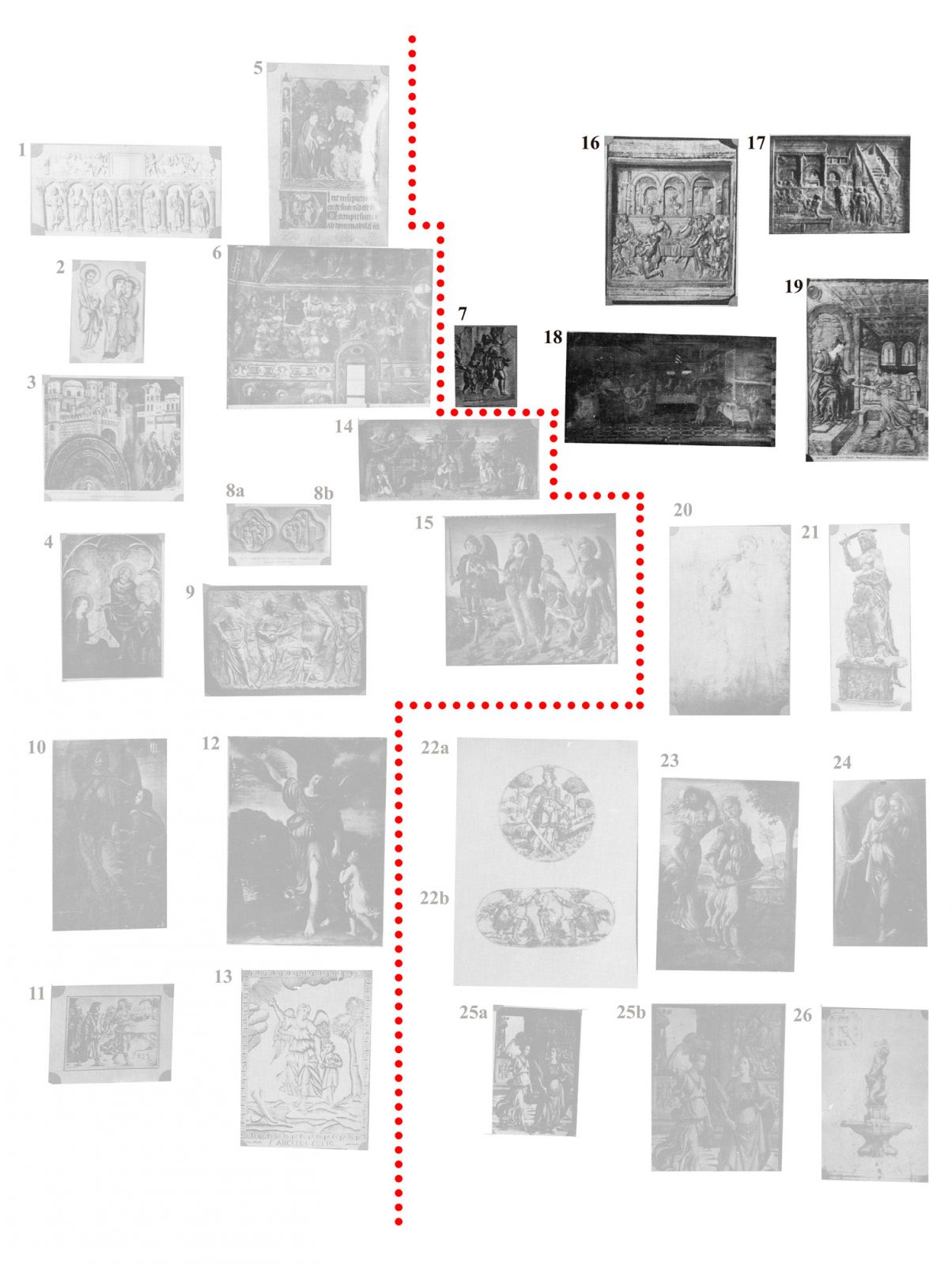
Another figure comparable with the angel and Judith for obvious thematic and formal relationships, and equally obvious contrasts, is Salome. In the Gospel, the young daughter of Herodias asks her stepfather Herod for the head of John the Baptist as a reward for her seductive dance:
On Herod’s birthday the daughter of Herodias danced for the guests and pleased Herod so much that he promised with an oath to give her whatever she asked. Prompted by her mother, she said, “Give me here on a platter the head of John the Baptist.” The king was distressed, but because of his oaths and his dinner guests, he ordered that her request be granted and had John beheaded in the prison. His head was brought in on a platter and given to the girl, who carried it to her mother (Mt, 14, 3-11, cfr. Mc 6, 17-28).
In the logic of the composition of this plate, the negative version of Judith, the heroic head-huntress who seduces and beheads the enemy to save her people, is Salomè, who on a lustful whim, or that of her mother, has John the Baptist beheaded.
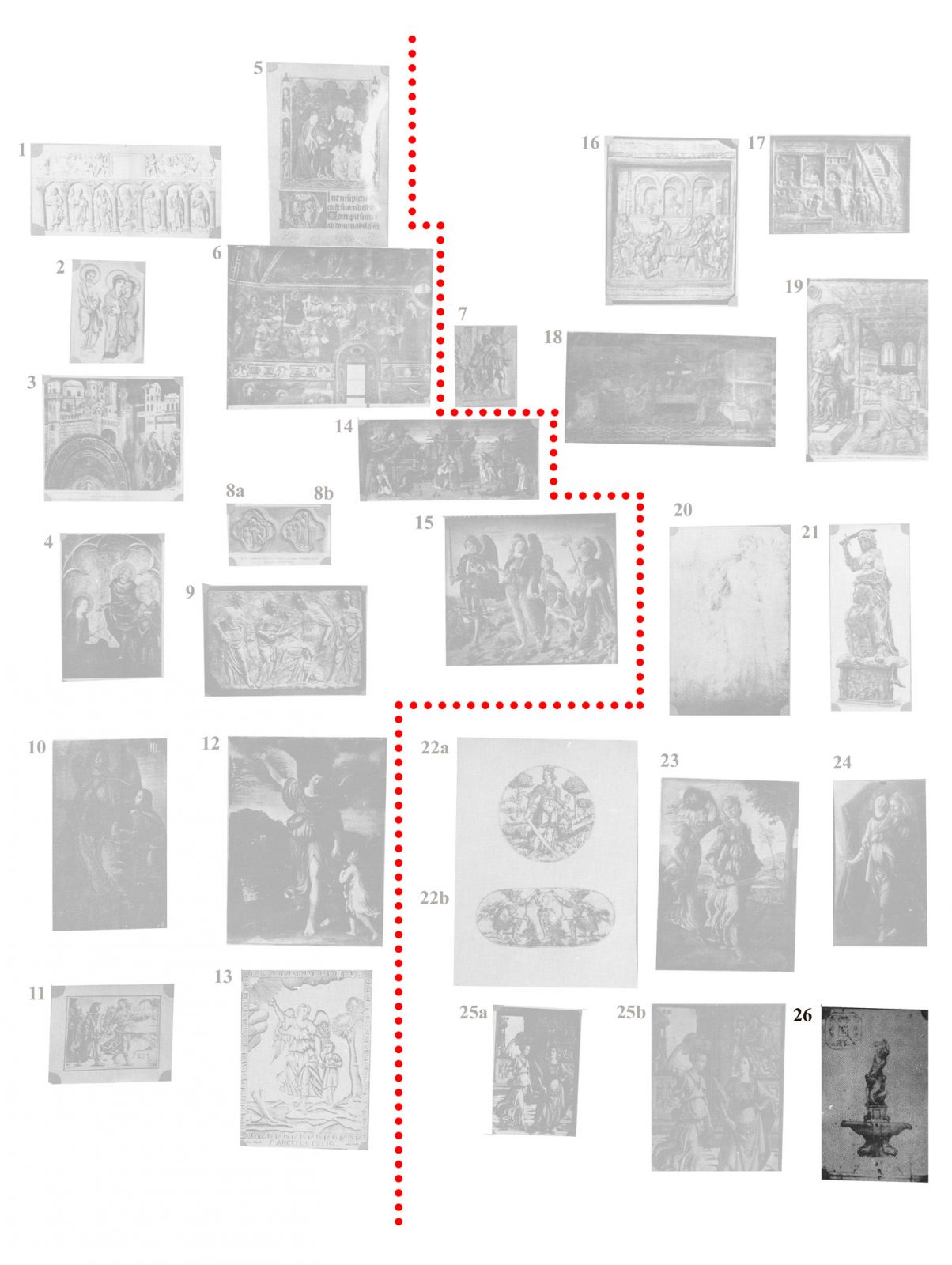
The right section of the Panel closes with a drawing of a fountain by Giambologna [47.26], in which Sampson is portrayed in the act of killing a Philistine with an ass’s jawbone (Judges 15, 9-20). The inclusion in the series of images of Sampson is explained by the thematic affinity of liberation from tyrannical oppression. On a formal level, the figure of Sampson wielding the jawbone of an ass as a weapon against the enemy is comparable to that of Judith, who raises her sword in the act of beheading Holophernes. In the biblical story of Sampson, however, especially in the episode that involves Delilah (Judges 16, 4-21); another feature also runs through all the figures in this section of the Panel, from Judith to Salome: the pathos of seduction as an incentive or deterrent in heroic undertakings.

Mnemosyne Atlas, Plate 47 (details from Mnemosyne 1929, by Warburg and coll.): figg. 47.21, 47.26.
47.21 Donatello, Judith and Holophernes, bronze, 1446-1460, Firenze, Piazza della Signoria; 47.26 Plan and prospect of a fountain with Samson Kills a Philistine by Giambologna, pen drawing, c. 1601, Firenze, Gabinetto Disegni e Stampe degli Uffizi.
In light of all these factors, Panel 47 appears to be crossed by the theme of enterprise as a mental space for exploration, of instability, of the journey from one condition to another; as the locus of uncertainty and danger, in which the power of Fortuna, in both a negative and positive sense, comes into play. The fact that all the journeys undertaken by the protagonists of the events depicted in the images in the plate come to fruition, and end in victory and the realisation of hope, is significant. But the ways in which the routes of the enterprise are undertaken differ, (once again, the contradictory relationship between the two vertical sections of the plate proves to be important): the initiation journey of Tobias and Jesus has an element of emotional protection; the journey of Judith, as well as the actions of Salome and Sampson (in the works in the right section of the plate), have seduction, violence, victorious struggle, blood and death as their distinguishing attributes.
Plastic Paths: Formulas of Pathos of the guide and of aggression
I. Gestures of protection
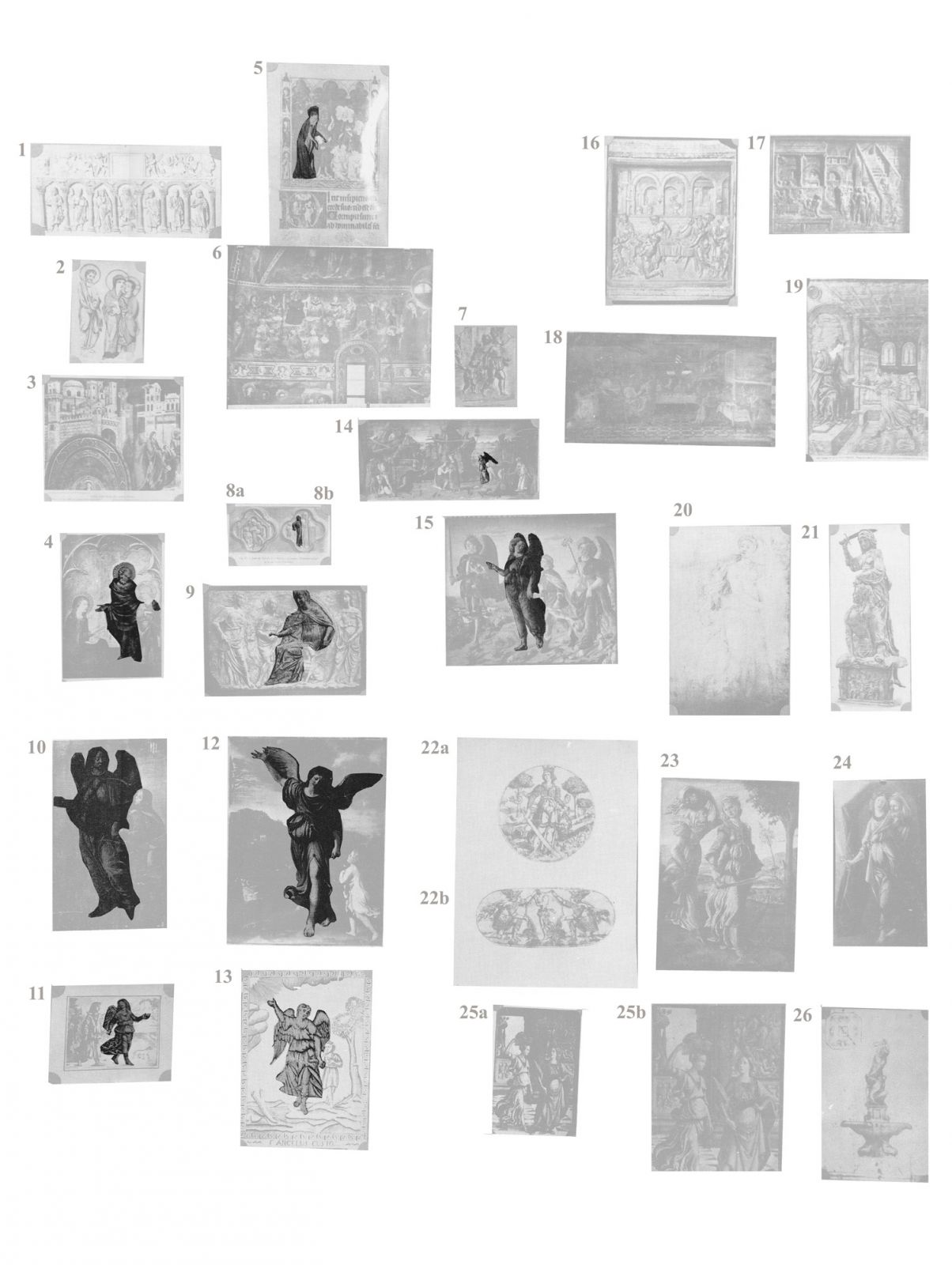
The works that take up the whole left side of the plate return to adult gestures of protection towards a younger figure (Jesus as a child or a young boy, Tobias the boy; and the child protected by the guardian angel), with wide-ranging degrees of affection: the hand placed on the shoulder [47.4, 47.5], hands joined together gently [47.10, 47.12, 47.15], or firmly [47.8b, 47.9, 47.11, 47.13, 47.14].

Mnemosyne Atlas, Plate 47 (details from Mnemosyne 1929, by Warburg and coll.): figg. 47.5, 47 15, 47.13.
47.5. Christ among the Doctors, miniature from "Queen Mary's Psalter", c. 1310-1330, Royal Ms. B VII, fol. 150v, The British Library; 47.15 Francesco Botticini, The Three Archangels and Tobias, tempera on wood panel, 1467, Florence, Uffizi Gallery; 47.13 Tobias and the Angel, print by Giorgio Nicodemi, in I legni incisi dei Musei Bresciani, Brescia 1921, p. 32.
II. The gesture of guidance and showing the way
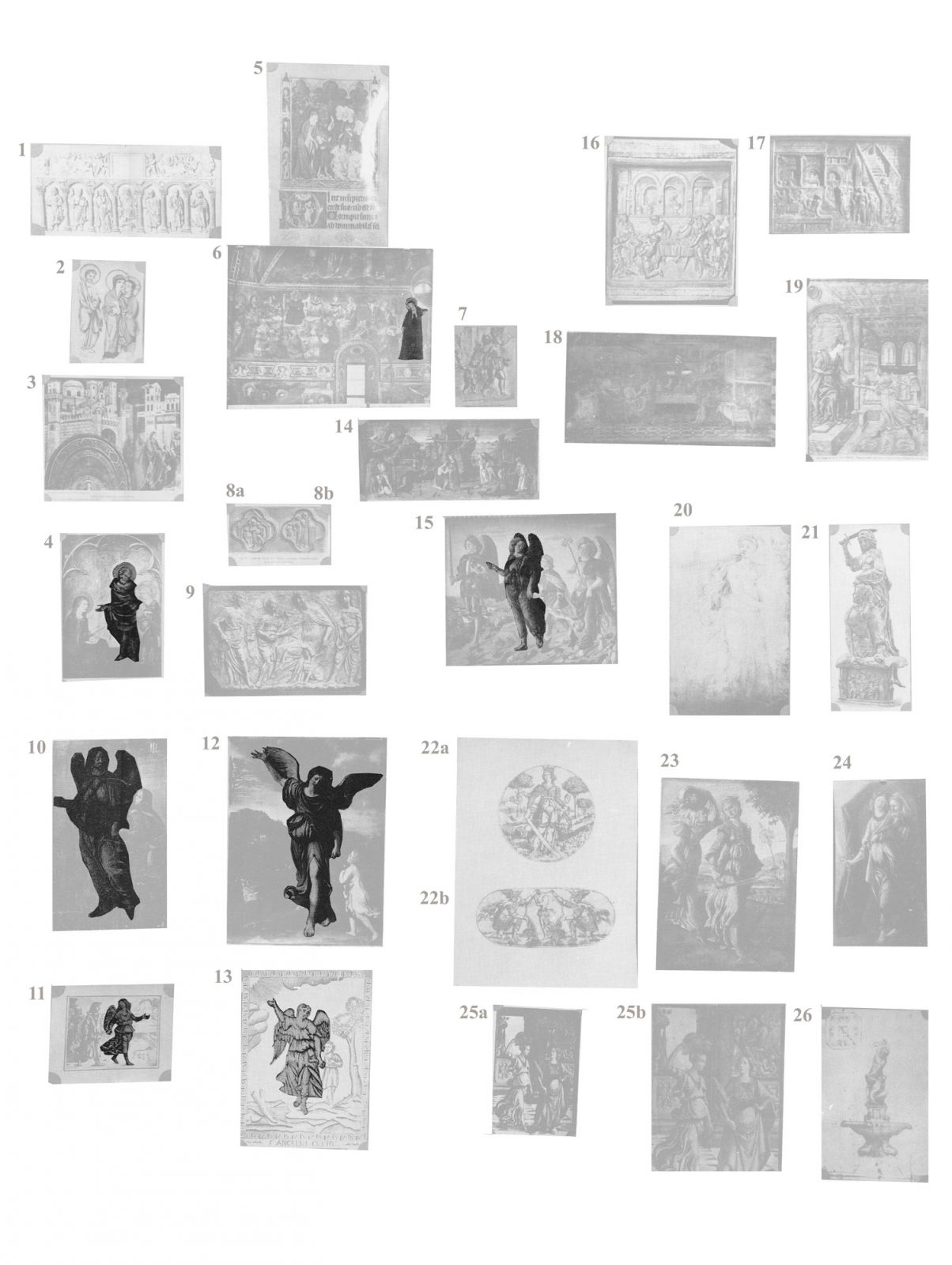
In the left section of the plate, the gesture with which the adult figure shows the way to a younger one recurs. Either Joseph or Mary indicates to their rebellious son Jesus the way back to the safety of home [47.4, 47.6]; the angel-Fortuna who leads the young merchant home after he has successfully completed his undertaking [47.10, 47.15]; finally, the guardian angel who shows the child the route to salvation via the sky [47.12. 47.13].

Mnemosyne Atlas, Plate 47 (details from Mnemosyne 1929, by Warburg and coll.): figg. 47.4, 47.11. 47.10, 47.13.
47.4. Simone Martini, The Return of Christ to his Parents, tempera on wood panel, 1342, Liverpool, Walker Art Gallery; 47.11 Giulio Campagnola, Tobias and the Angel Raphael, etching on copper, c. 1500; 47.10 Francesco Botticini, Tobias and the Angel, and the Young Donor (son of the patron Raffaello Doni), tempera on wood panel, c. 1495, Florence, Santa Maria del Fiore, Old Sacristy; 47.13. Tobias and the Angel, print by Giorgio Nicodemi, in I legni incisi dei Musei Bresciani, Brescia 1921, p. 32.
III. Postures of aggression and violence
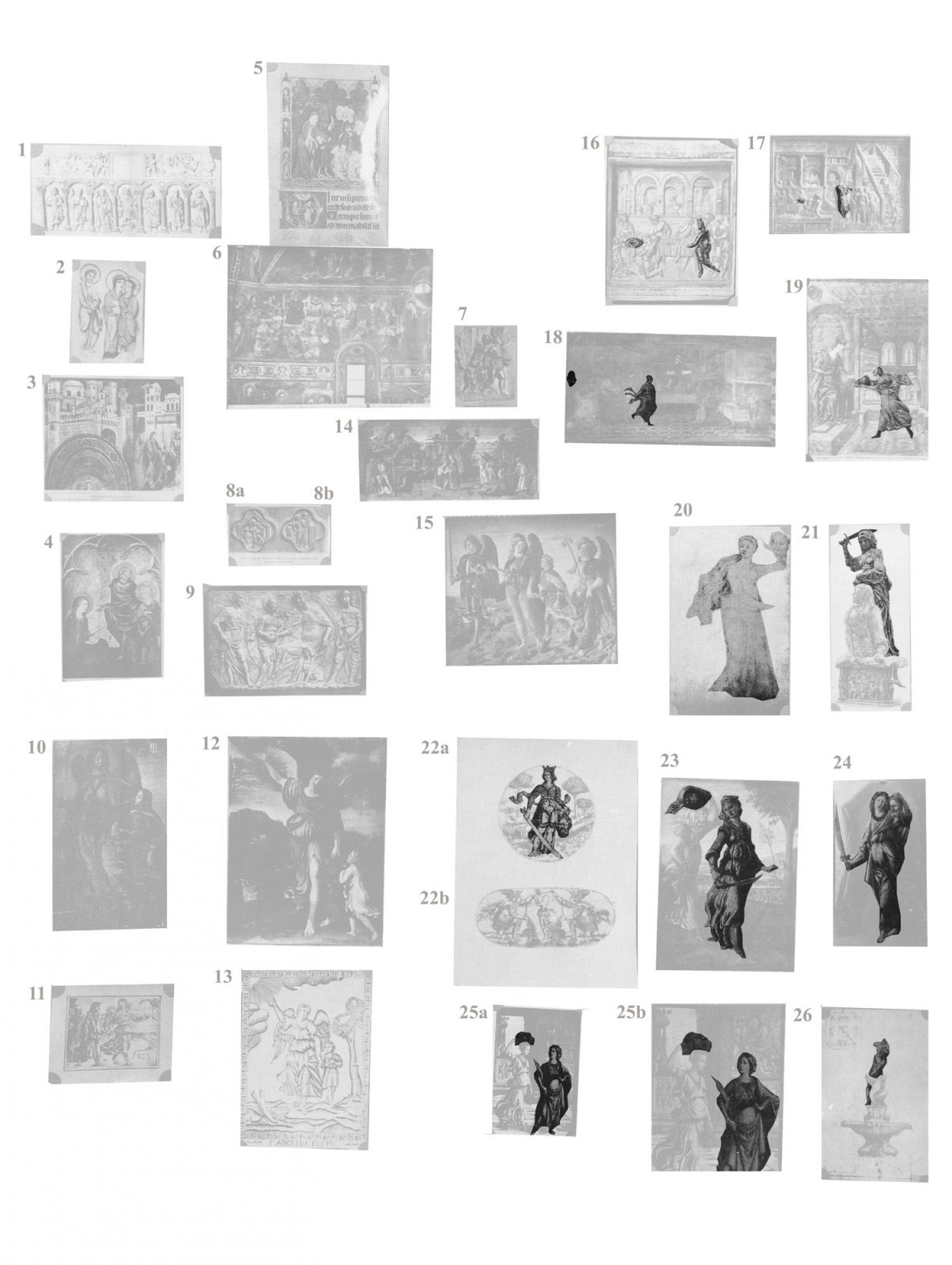
The gestures of protection and guidance that characterise the figures of the angels and the stories of Jesus contrast with the formulas of aggression and violence that permeate the entire right side of the plate. The arms of Judith and Sampson, raised in the act of delivering their blow [47.21, 47.26]; the heroic posture [47.22a] or the triumphant step [47.20, 47.23, 47.24] which signals the conclusion of Judith’s mission, with the weapon in her hand and the head of Holophernes placed on display by herself or by her trustworthy maidservant [47.23, 47.25]; the grace of the dancing and murderous Salome [47.16, 47.17, 47.18], who in Pollaiuolo’s altar frontal personally hands the trophy of the head of John the Baptist to her mother Herodias [47.19].

Mnemosyne Atlas, Plate 47 (details from Mnemosyne 1929, by Warburg and coll.): figg. 47.21, 47.22a, 47.24, 47.25a, 47.18 (det.), 47.19.
47.21 Donatello, Judith and Holophernes, bronze, 1446-1460, Florence, Piazza della Signoria; 47.22a Judith Holding the Head of Holophernes, etching on copper, c. 1465, London, The British Museum; 47.24 Sandro Botticelli, Judith with the head of Holophernes, tempera on wood panel, 1497-1500, Amsterdam, Rijksmuseum; 47.25a Workshop of Ghirlandaio, Judith with the Head of Holophernes, oil on wood panel, 1489, Berlin, Staatliche Museen, Gemäldegalerie; 47.18 Filippo Lippi, Salomè Dancing before Herod, fresco, c. 1464, Prato, Duomo, south wall of the chancel; 47.19 Antonio Pollaiuolo, Herodias Receives the Head of Saint John the Baptist, altar frontal with cycle of The Stories of the Baptist, Florence, Museo dell’Opera del Duomo.
IV. The stride of the Nympha
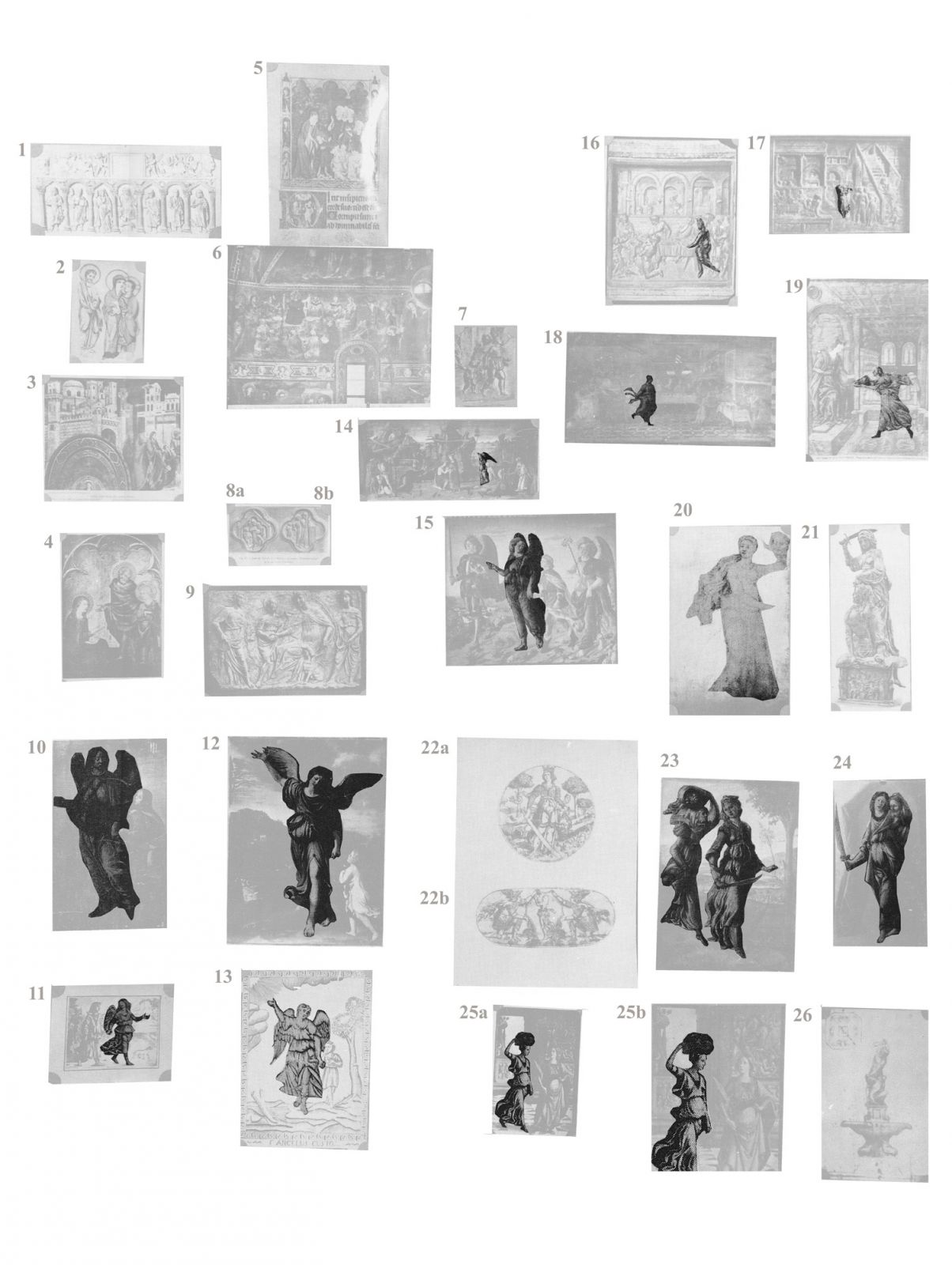
In 1893, Warburg wrote:
"The nymph was one of those attractive offspring of a multiple conjunction of art and archaeology, such as only the Quattrocento could produce." Aby Warburg, Theatrical Costumes for the Intermedi of 1589, [1895] in The Renewal of Pagan Antiquity, introduction by K. W. Forster, trans. by D. Britt, Getty Research Institure for the History of Art and the Humanities, Los Angeles 1999, 381.
The phantom of the Nymph, a formal footprint of antiquity in which the grace of a young female with a light, dancing step and garments fluttering in the breeze, fixed in an expressive figurative formula, continues its path through the plates of the Atlas (see principally plate 39 and plate 46 of the Atlas, which start with archaeological images heralded in plates 4-8) changing name, gender and narrative role. Warburg himself indicates this reappearance; the word "ninfa" (in Italian!) opens the note related to plate 47 in which the ancient form re-emerges in the two figures, at first consideration, unrelated: the Angel and the Head-huntress:
“Ninfa als Schutzengel und als Kopfjägerin. Herbeitragen des Kopfes”
[Nymph as guardian angel and head-huntress. Carrying heads].

Mnemosyne Atlas, Plate 47 (details from Mnemosyne 1929, by Warburg and coll.): figg. 47.10. 47.11, 47.23, 47.19.
47.10 Francesco Botticini, Tobias and the Angel, and the Young Donor (son of the patron Raffaello Doni), tempera on wood panel, c. 1495, Florence, Santa Maria del Fiore, Sacrestia vecchia; 47.11 Giulio Campagnola, Tobias and the Angel Raphael, etching on copper, c. 1500; 47.23. Sandro Botticelli, The Return of Judith, tempera on wood panel, part of a diptych, c. 1470, Florence, Uffizi Gallery; 47.19 Antonio Pollaiuolo, Herodias Receives the Head of Saint John the Baptist, altar frontal with cycle of The Stories of the Baptist, Florence, Museo dell’Opera del Duomo.
The assimilation of angel/nymph is also confirmed in technical and artistic renaissance treatises, explicit in this passage from the Treatise on Painting by Leonardo da Vinci:
"...reveal as it were the true size of the limbs only in a nymph or an angel, who is represented in filmy garments that flutter and cling in the breeze; with these, and their like, the form of their limbs may very well be revealed." Leonardo, Treatise on Painting IV, 527 (quoted by Warburg in Sandro Botticelli's Birth of Venus and Spring [1893], in The Renewal of Pagan Antiquity, introduction by K. W. Forster, trans. by D. Britt, Getty Research Institure for the History of Art and the Humanities, Los Angeles 1999, 140).
Angel or head-huntress: the nymph appears not only as a positive figure, but also in the guise of Salome, the girl who receives the head of John the Baptist as a reward for her dancing, or as a seductive Judith stepping proudly into the scene (for the first re-emersions of the figure of the nymph see the essay by A. Pedersoli, I capelli delle ninfe fiorentine, in “La Rivista di Engramma” 68, December 2008).
The note relating to Panel 47 written by Warburg and his collaborators provides a clarification for reading the plate: in the montage, the figurative formula for “bearing a head” has its own autonomy with regard to the protagonist of the beheading. It is not always the heroine Judith/Salome – the new nympha gradiva – who displays the head of Holophernes/John as a trophy of her mission, but the bearing of the severed head can be delegated to a secondary figure: in several works included in the plate, a maid with a graceful step follows the protagonist of the episode narrated in the bible. She is the same basket-bearing maid of Plate 46, – the “Bridget-bring-it-quick” nymph who re-emerges in the domestic context (in his note on Panel 46 Warburg writes: “Eilbringitte 'Tornabuoni-im Kreise. Domestizierung”) – no longer bearing a basket full of fruit on her head, but the severed head of the victim.

Mnemosyne Atlas, Plate 47 details from Mnemosyne 1929, by Warburg and coll.): figg. 47.24, 47.23.
47.24 Sandro Botticelli, Judith Holding the Head of Holophernes, tempera on wood panel, 1497-1500, Amsterdam, Rijksmuseum; 47.23 Sandro Botticelli, The Return of Judith, tempera on wood panel, part of a diptych, c. 1470, Florence, Uffizi Gallery.
The angel, Judith and Salome appear together in another text written by Warburg published in 1905, as figures able to weave expressive and thematic threads later displayed in the Atlas:
“It is like the dresses of the flying Victories on Roman triumphal arches, or of those dancing maenads, consciously imitated from the antique, who first appeared in the works of Donatello and of Filippo Lippi. Those figures revived the loftier antique style of life in motion, as we find it in the homeward-bound Judith, or in the angelic companion of Tobias, or in the dancing Salome, who emerged on biblical pretexts from the workshops of Pollaiuolo, Verrocchio, Botticelli, and Ghirlandaio, grafting eternal shoots of pagan antiquity onto the withered rootstock of Flemish-influenced bourgeois painting." Aby Warburg, On Imprese amorose, [1905], in The Renewal of Pagan Antiquity, introduction by K. W. Forster, trans. by D. Britt, Getty Research Institure for the History of Art and the Humanities, Los Angeles 1999, 174.
But the association between Salome, Judith, the Angel and the handmaiden of the Tornabuoni Chapel was already evoked in the intense correspondence between Warburg and André Jolles which focussed on their obsession for the Nymph, of which traces remain in a witty game in an exchange of letters that began in 1900:
"What has happened? Cherchez la femme, my dear. It’s about a lady who is playing a wicked game with me. I started an intellectual flirtation with her, and I am now her victim. I chase her, or is it she who chases me? I no longer know... Sometimes she is Salome, who comes dancing with lethal charm before the licentious tetrarch; sometimes she is Judith who proud and triumphant walks cheerfully bearing the head of the assassinated general. And then she seems to hide in the childlike grace of Tobias who bravely and confidently goes to meet his intended wife. Sometimes I glimpse her in a seraph flying in adoration towards God, and sometimes in Gabriel, bearing his good news. I see her joyous and innocent like a bridesmaid at a wedding, I see her dressed as a mother, terrified and escaping from the Slaughter of the Innocents. I have tried to see her anew, like I saw her the first time in the choir of Santa Maria Novella, but in the meantime she has doubled […] Said in another way, and seriously: what is the story of this young girl”. Letter from Jolles to Warburg, 23 December 1900, in Warburg, Le opere, edited by M. Ghelardi, 248 (on the exchange of letters between Warburg-Jolles see S. Contarini, M. Ghelardi, "Die Bewegung verkoerperte": the nymph, "aut aut" 321-322, 2004, 32-45, followed by A. Jolles and A. Warburg, La ninfa: uno scambio di lettere, "aut aut" 321-322, 2004, 46-52).
Connections between Plates 46, 48 and 77
From an analysis of the contents and postures shown in Panel 47 in relation to the plates that precede and follow it in the Atlas emerges a complex and layered reading in terms of occurrences and transformation of formulas of Pathos, and iconographic conventions. Previously, in Panel 46, the image of the ancient nymph re-emerges as a figure of vitality and sudden movement, and the bearer appears in works in the plate in various guises and resemanticisations depending on contexts. Panel 46 also anticipates the themes of caring for a child, and “affectionate” gestures [46.3].
In the plate that follows, Panel 48, another milestone of the re-emergence of antiquity is staged: the plate is dedicated to a crucial figure of humanistic culture – the image of Fortuna in a wind-blown garment. A symbol of man’s intellectual emancipation from servitude to divine predestination, the image from antiquity continues, however, to feed off the conflict and oscillations between the timing of those who manage to seize an opportunity (metaphorically to grab it by the forelock) and the fears of those who devoutly entrust themselves to her. An example of the paradox of the coexistence of faith and self-awareness is shown by the merchant class that commissioned the votive image of archangel Raphael, and who find in the figure of Fortuna with a sail an image that is appropriate for representing the instability of material fortune.
At some distance further on in the Atlas, Panel 76 returns to the subject of caring for children illustrated with sixteenth and seventeenth-century works from northern Europe, with Tobias and the Angel, the Return from the Temple, Rest on the Flight to Egypt, as subjects. The works assembled in Plate 76 are formally characterised by the association of an adult figure (the angel, the Virgin Mary) holding the hand of a child (Tobit; Jesus). The affectionate gestures of the character-guide reiterate his/her protective role. However, the adult figure in movement – the montage suggests – reflects the formal and semantic models of antiquity: the relief with Christ-Ecclesia (previously in Plate 47) can be related to the statue of the Vestal in the Loggia dei Lanzi; the figure of the desperately and ineffectually protective mother is embodied by Niobe (a prominent figure in Plate 5), the mythical prototype who cannot put into operation any defence in favour of her children because they are subject to the wrath of the gods.
At the very end of the Atlas, in the panels dedicated to the re-emergence of the old formulas in a strictly contemporary context, the themes of the Angel and the head-huntress return: Warburg himself mentions this in a gloss on Plate 77: “Nike und Tobiuzzolo in der reklame”. Now Judith is reincarnated in the depiction of the Golfer, immortalised at the moment of dynamic tension in the act of delivering the blow; Tobias now reappears in an advertisement for a book of recipes, as the child witness of the health benefits of fish, with the slogan “EßT FISCH”.

Mnemosyne Atlas, 47.21 Donatello, Judith and Holophernes, bronze, 1446-1460, Florence, Piazza della Signoria; Mnemosyne Atlas 77.5 Photograph of the golf champion EriKa Sell-Schopp, from “Frau und Gegenwart”; Mnemosyne Atlas 47.15 Francesco Botticini, The Three Archangels and Tobias, tempera on wood panel, 1467, Florence, Uffizi Gallery; Mnemosyne Atlas 77.6a “EßT FISCH”, cover for a book of fish recipes.
A first version of the reading on Plate 47 of Mnemosyne Atlas, in "La Rivista di Engramma" n. 20 (ottobre 2002)
To cite this article: Seminario Mnemosyne, The Angel and the Head-huntress. A Reading of Plate 47 of the Mnemosyne Atlas, “La Rivista di Engramma” n. 119, settembre 2014, pp. 71-88 | PDF of the article